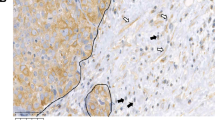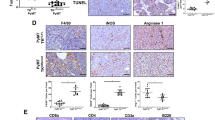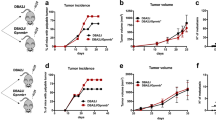Abstract
Increased expression of HBEGF in estrogen receptor-negative breast tumors is correlated with enhanced metastasis to distant organ sites and more rapid disease recurrence upon removal of the primary tumor. Our previous work has demonstrated a paracrine loop between breast cancer cells and macrophages in which the tumor cells are capable of stimulating macrophages through the secretion of colony-stimulating factor-1 while the tumor-associated macrophages (TAMs), in turn, aid in tumor cell invasion by secreting epidermal growth factor. To determine how the autocrine expression of epidermal growth factor receptor (EGFR) ligands by carcinoma cells would affect this paracrine loop mechanism, and in particular whether tumor cell invasion depends on spatial ligand gradients generated by TAMs, we generated cell lines with increased HBEGF expression. We found that autocrine HBEGF expression enhanced in vivo intravasation and metastasis and resulted in a novel phenomenon in which macrophages were no longer required for in vivo invasion of breast cancer cells. In vitro studies revealed that expression of HBEGF enhanced invadopodium formation, thus providing a mechanism for cell autonomous invasion. The increased invadopodium formation was directly dependent on EGFR signaling, as demonstrated by a rapid decrease in invadopodia upon inhibition of autocrine HBEGF/EGFR signaling as well as inhibition of signaling downstream of EGFR activation. HBEGF expression also resulted in enhanced invadopodium function via upregulation of matrix metalloprotease 2 (MMP2) and MMP9 expression levels. We conclude that high levels of HBEGF expression can short-circuit the tumor cell/macrophage paracrine invasion loop, resulting in enhanced tumor invasion that is independent of macrophage signaling.
This is a preview of subscription content, access via your institution
Access options
Subscribe to this journal
Receive 50 print issues and online access
$259.00 per year
only $5.18 per issue
Buy this article
- Purchase on Springer Link
- Instant access to full article PDF
Prices may be subject to local taxes which are calculated during checkout






Similar content being viewed by others
References
Jemal A, Siegel R, Xu J, Ward E . Cancer statistics, 2010. CA Cancer J Clin 2010; 60: 277–300.
Fidler IJ . The pathogenesis of cancer metastasis: the ‘seed and soil’ hypothesis revisited. Nat Rev Cancer 2003; 3: 453–458.
Place AE, Jin Huh S, Polyak K . The microenvironment in breast cancer progression: biology and implications for treatment. Breast Cancer Res 2011; 13: 227.
Artacho-Cordon A, Artacho-Cordon F, Rios-Arrabal S, Calvente I, Nunez MI . Tumor microenvironment and breast cancer progression: a complex scenario. Cancer Biol Ther 2012; 13: 14–24.
Xue C, Wyckoff J, Liang F, Sidani M, Violini S, Tsai KL et al. Epidermal growth factor receptor overexpression results in increased tumor cell motility in vivo coordinately with enhanced intravasation and metastasis. Cancer Res 2006; 66: 192–197.
Wyckoff JB, Wang Y, Lin EY, Li JF, Goswami S, Stanley ER et al. Direct visualization of macrophage-assisted tumor cell intravasation in mammary tumors. Cancer Res 2007; 67: 2649–2656.
Wyckoff J, Wang W, Lin EY, Wang Y, Pixley F, Stanley ER et al. A paracrine loop between tumor cells and macrophages is required for tumor cell migration in mammary tumors. Cancer Res 2004; 64: 7022–7029.
Goswami S, Sahai E, Wyckoff JB, Cammer M, Cox D, Pixley FJ et al. Macrophages promote the invasion of breast carcinoma cells via a colony-stimulating factor-1/epidermal growth factor paracrine loop. Cancer Res 2005; 65: 5278–5283.
Patsialou A, Wyckoff J, Wang Y, Goswami S, Stanley ER, Condeelis JS . Invasion of human breast cancer cells in vivo requires both paracrine and autocrine loops involving the colony-stimulating factor-1 receptor. Cancer Res 2009; 69: 9498–9506.
Harris RC, Chung E, Coffey RJ . EGF receptor ligands. Exp Cell Res 2003; 284: 2–13.
Singh AB, Harris RC . Autocrine, paracrine and juxtacrine signaling by EGFR ligands. Cell Signal 2005; 17: 1183–1193.
Ongusaha PP, Kwak JC, Zwible AJ, Macip S, Higashiyama S, Taniguchi N et al. HB-EGF is a potent inducer of tumor growth and angiogenesis. Cancer Res 2004; 64: 5283–5290.
Revillion F, Lhotellier V, Hornez L, Bonneterre J, Peyrat JP . ErbB/HER ligands in human breast cancer, and relationships with their receptors, the bio-pathological features and prognosis. Ann Oncol 2008; 19: 73–80.
Yotsumoto F, Oki E, Tokunaga E, Maehara Y, Kuroki M, Miyamoto S . HB-EGF orchestrates the complex signals involved in triple-negative and trastuzumab-resistant breast cancer. Int J Cancer 2010; 127: 2707–2717.
Gyorffy B, Lanczky A, Eklund AC, Denkert C, Budczies J, Li Q et al. An online survival analysis tool to rapidly assess the effect of 22,277 genes on breast cancer prognosis using microarray data of 1,809 patients. Breast Cancer Res Treat 2010; 123: 725–731.
Kedrin D, Wyckoff J, Boimel PJ, Coniglio SJ, Hynes NE, Arteaga CL et al. ERBB1 and ERBB2 have distinct functions in tumor cell invasion and intravasation. Clinical Cancer Res 2009; 15: 3733–3739.
Mitamura T, Higashiyama S, Taniguchi N, Klagsbrun M, Mekada E . Diphtheria toxin binds to the epidermal growth factor (EGF)-like domain of human heparin-binding EGF-like growth factor/diphtheria toxin receptor and inhibits specifically its mitogenic activity. J Biol Chem 1995; 270: 1015–1019.
Hernandez L, Smirnova T, Wyckoff J, Condeelis J, Segall JE . In vivo assay for tumor cell invasion. Methods Mol Biol 2009; 571: 227–238.
Smirnova T, Adomako A, Locker J, Van Rooijen N, Prystowsky MB, Segall JE . In vivo invasion of head and neck squamous cell carcinoma cells does not require macrophages. Am J Pathol 2011; 178: 2857–2865.
Roussos ET, Balsamo M, Alford SK, Wyckoff JB, Gligorijevic B, Wang Y et al. Mena invasive (MenaINV) promotes multicellular streaming motility and transendothelial migration in a mouse model of breast cancer. J Cell Sci 2011; 124 (Pt 13): 2120–2131.
Qian B, Deng Y, Im JH, Muschel RJ, Zou Y, Li J et al. A distinct macrophage population mediates metastatic breast cancer cell extravasation, establishment and growth. PloS One 2009; 4: e6562.
Bonde AK, Tischler V, Kumar S, Soltermann A, Schwendener RA . Intratumoral macrophages contribute to epithelial-mesenchymal transition in solid tumors. BMC Cancer 2012; 12: 35.
Zaynagetdinov R, Sherrill TP, Polosukhin VV, Han W, Ausborn JA, McLoed AG et al. A critical role for macrophages in promotion of urethane-induced lung carcinogenesis. J Immunol 2011; 187: 5703–5711.
Zeisberger SM, Odermatt B, Marty C, Zehnder-Fjallman AH, Ballmer-Hofer K, Schwendener RA . Clodronate-liposome-mediated depletion of tumour-associated macrophages: a new and highly effective antiangiogenic therapy approach. Br J Cancer 2006; 95: 272–281.
Murphy DA, Courtneidge SA . The ‘ins’ and ‘outs’ of podosomes and invadopodia: characteristics, formation and function. Nat Rev Mol Cell Biol 2011; 12: 413–426.
Oser M, Mader CC, Gil-Henn H, Magalhaes M, Bravo-Cordero JJ, Koleske AJ et al. Specific tyrosine phosphorylation sites on cortactin regulate Nck1-dependent actin polymerization in invadopodia. J Cell Sci 2010; 123 (Pt 21): 3662–3673.
Yamaguchi H, Lorenz M, Kempiak S, Sarmiento C, Coniglio S, Symons M et al. Molecular mechanisms of invadopodium formation: the role of the N-WASP-Arp2/3 complex pathway and cofilin. J Cell Biol 2005; 168: 441–452.
Mader CC, Oser M, Magalhaes MA, Bravo-Cordero JJ, Condeelis J, Koleske AJ et al. An EGFR-Src-Arg-cortactin pathway mediates functional maturation of invadopodia and breast cancer cell invasion. Cancer Res 2011; 71: 1730–1741.
Ammer AG, Weed SA . Cortactin branches out: roles in regulating protrusive actin dynamics. Cell Motil Cytoskeleton 2008; 65: 687–707.
Deryugina EI, Quigley JP . Matrix metalloproteinases and tumor metastasis. Cancer Metastasis Rev 2006; 25: 9–34.
Artym VV, Zhang Y, Seillier-Moiseiwitsch F, Yamada KM, Mueller SC . Dynamic interactions of cortactin and membrane type 1 matrix metalloproteinase at invadopodia: defining the stages of invadopodia formation and function. Cancer Res 2006; 66: 3034–3043.
Yagi H, Yotsumoto F, Miyamoto S . Heparin-binding epidermal growth factor-like growth factor promotes transcoelomic metastasis in ovarian cancer through epithelial-mesenchymal transition. Mol Cancer Ther 2008; 7: 3441–3451.
Lue HW, Yang X, Wang R, Qian W, Xu RZ, Lyles R et al. LIV-1 promotes prostate cancer epithelial-to-mesenchymal transition and metastasis through HB-EGF shedding and EGFR-mediated ERK signaling. PloS One 2011; 6: e27720.
Joslin EJ, Opresko LK, Wells A, Wiley HS, Lauffenburger DA . EGF-receptor-mediated mammary epithelial cell migration is driven by sustained ERK signaling from autocrine stimulation. J Cell Sci 2007; 120 (Pt 20): 3688–3699.
Hayes KE, Walk EL, Ammer AG, Kelley LC, Martin KH, Weed SA . Ableson kinases negatively regulate invadopodia function and invasion in head and neck squamous cell carcinoma by inhibiting an HB-EGF autocrine loop. Oncogene (e-pub ahead of print 12 November 2012; doi:10.1038/onc.2012.513).
Joslin EJ, Shankaran H, Opresko LK, Bollinger N, Lauffenburger DA, Wiley HS . Structure of the EGF receptor transactivation circuit integrates multiple signals with cell context. Mol Biosystems 2010; 6: 1293–1306.
Wilson KJ, Mill C, Lambert S, Buchman J, Wilson TR, Hernandez-Gordillo V et al. EGFR ligands exhibit functional differences in models of paracrine and autocrine signaling. Growth Factors 2012; 30: 107–116.
Shimura T, Yoshida M, Fukuda S, Ebi M, Hirata Y, Mizoshita T et al. Nuclear translocation of the cytoplasmic domain of HB-EGF induces gastric cancer invasion. BMC Cancer 2012; 12: 205.
Nishi E, Klagsbrun M . Heparin-binding epidermal growth factor-like growth factor (HB-EGF) is a mediator of multiple physiological and pathological pathways. Growth Factors 2004; 22: 253–260.
Tolino MA, Block ER, Klarlund JK . Brief treatment with heparin-binding EGF-like growth factor, but not with EGF, is sufficient to accelerate epithelial wound healing. Biochim Biophys Acta 2011; 1810: 875–878.
Scott J, Patterson S, Rall L, Bell GI, Crawford R, Penschow J et al. The structure and biosynthesis of epidermal growth factor precursor. J Cell Sci Suppl 1985; 3: 19–28.
Roepstorff K, Grandal MV, Henriksen L, Knudsen SL, Lerdrup M, Grovdal L et al. Differential effects of EGFR ligands on endocytic sorting of the receptor. Traffic 2009; 10: 1115–1127.
Garton KJ, Ferri N, Raines EW . Efficient expression of exogenous genes in primary vascular cells using IRES-based retroviral vectors. BioTechniques 2002; 32: 830, 2, 4 passim.
Roussos ET, Goswami S, Balsamo M, Wang Y, Stobezki R, Adler E et al. Mena invasive (Mena(INV)) and Mena11a isoforms play distinct roles in breast cancer cell cohesion and association with TMEM. Clin Exp Metastasis 2011; 28: 515–527.
Smirnova T, Zhou ZN, Flinn RJ, Wyckoff J, Boimel PJ, Pozzuto M et al. Phosphoinositide 3-kinase signaling is critical for ErbB3-driven breast cancer cell motility and metastasis. Oncogene 2012; 31: 706–715.
Coniglio SJ, Eugenin E, Dobrenis K, Stanley ER, West BL, Symons MH et al. Microglial stimulation of glioblastoma invasion involves epidermal growth factor receptor (EGFR) and colony stimulating factor 1 receptor (CSF-1R) signaling. Mol Med 2012; 18: 519–527.
Kedrin D, Wyckoff J, Sahai E, Condeelis J, Segall JE . Imaging tumor cell movement in vivo. Curr Protoc Cell Biol 2007, Chapter 19; 1–17.
Van Rooijen N, Sanders A . Liposome mediated depletion of macrophages: mechanism of action, preparation of liposomes and applications. J Immunol Methods 1994; 174: 83–93.
Artym VV, Yamada KM, Mueller SC . ECM degradation assays for analyzing local cell invasion. Methods Mol Biol 2009; 522: 211–219.
Artym VV, Matsumoto K, Mueller SC, Yamada KM . Dynamic membrane remodeling at invadopodia differentiates invadopodia from podosomes. Eur J Cell Biol 2011; 90: 172–180.
Sharma VP, Entenberg D, Condeelis J . High-resolution live-cell imaging and time-lapse microscopy of invadopodium dynamics and tracking analysis. Methods Mol Biol 2013; 1046: 343–357.
Oser M, Yamaguchi H, Mader CC, Bravo-Cordero JJ, Arias M, Chen X et al. Cortactin regulates cofilin and N-WASp activities to control the stages of invadopodium assembly and maturation. J Cell Biol 2009; 186: 571–587.
Acknowledgements
We thank the Condeelis, Cox, Hodgson and Segall labs for their comments and suggestions. We thank Carl Manthey and Johnson and Johnson for providing the JnJ compound. JES is the Betty and Sheldon Feinberg Senior Faculty Scholar in Cancer Research. Funding was provided by CA100324 (ERS, ARB, DC, JWP, JC and JES), CA77522 (JES), T32-GM007288 (ZNZ), a postdoctoral fellowship from the Susan G. Komen for the Cure, KG111405 (VPS), an NIH F32 postdoctoral fellowship F32-CA159663-01 (MRJ) and an NIH 1K12GM102779-01 (EAP).
Author information
Authors and Affiliations
Corresponding author
Ethics declarations
Competing interests
JC has received compensation as a member of the scientific advisory board of MetaStat and owns stock in the company. The other authors declare no conflict of interest.
Additional information
Supplementary Information accompanies this paper on the Oncogene website
Supplementary information
Rights and permissions
About this article
Cite this article
Zhou, Z., Sharma, V., Beaty, B. et al. Autocrine HBEGF expression promotes breast cancer intravasation, metastasis and macrophage-independent invasion in vivo. Oncogene 33, 3784–3793 (2014). https://doi.org/10.1038/onc.2013.363
Received:
Revised:
Accepted:
Published:
Issue Date:
DOI: https://doi.org/10.1038/onc.2013.363
Keywords
This article is cited by
-
TC10 regulates breast cancer invasion and metastasis by controlling membrane type-1 matrix metalloproteinase at invadopodia
Communications Biology (2021)
-
E2F1 Drives Breast Cancer Metastasis by Regulating the Target Gene FGF13 and Altering Cell Migration
Scientific Reports (2019)
-
Degradation and Remodeling of Epitaxially Grown Collagen Fibrils
Cellular and Molecular Bioengineering (2019)
-
Cortactin and fascin-1 regulate extracellular vesicle release by controlling endosomal trafficking or invadopodia formation and function
Scientific Reports (2018)
-
Matricellular CCN6 (WISP3) protein: a tumor suppressor for mammary metaplastic carcinomas
Journal of Cell Communication and Signaling (2018)



